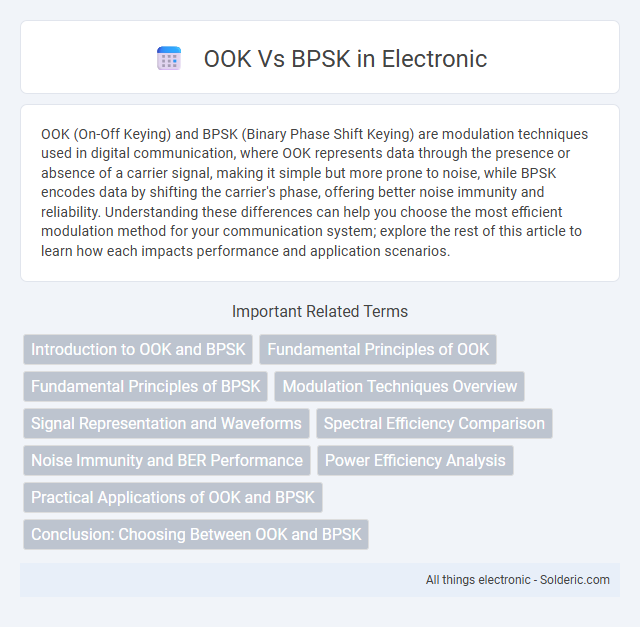OOK (On-Off Keying) and BPSK (Binary Phase Shift Keying) are modulation techniques used in digital communication, where OOK represents data through the presence or absence of a carrier signal, making it simple but more prone to noise, while BPSK encodes data by shifting the carrier's phase, offering better noise immunity and reliability. Understanding these differences can help you choose the most efficient modulation method for your communication system; explore the rest of this article to learn how each impacts performance and application scenarios.
Comparison Table
| Aspect | OOK (On-Off Keying) | BPSK (Binary Phase Shift Keying) |
|---|---|---|
| Modulation Type | Amplitude modulation | Phase modulation |
| Signal Representation | Presence or absence of carrier signal | Two distinct phases separated by 180deg |
| Power Efficiency | Lower power efficiency | Higher power efficiency |
| Bandwidth Usage | Wider bandwidth | Narrower bandwidth |
| Noise Immunity | Poor noise immunity | Better noise immunity |
| Complexity | Simple transmitter and receiver | More complex implementation |
| Applications | Optical communication, simple RF links | Satellite, wireless, and cellular communication |
Introduction to OOK and BPSK
On-Off Keying (OOK) is a simple form of amplitude shift keying that represents digital data through the presence or absence of a carrier wave, making it highly energy-efficient for short-range optical communication. Binary Phase Shift Keying (BPSK) modulates the phase of a carrier signal by 180 degrees to represent binary data, offering greater immunity to noise and improved performance in wireless systems. BPSK's robustness makes it preferred in environments where signal integrity is critical, while OOK is favored for its implementation simplicity and lower power consumption.
Fundamental Principles of OOK
On-Off Keying (OOK) is a modulation technique where the presence of a carrier signal represents a binary '1' and its absence represents a binary '0'. This simple binary modulation is achieved by switching the carrier wave on or off according to the digital data being transmitted, making it energy efficient and easy to implement. OOK fundamentally relies on amplitude variation and is widely used in optical communication and low-power wireless systems due to its simplicity and straightforward demodulation process.
Fundamental Principles of BPSK
Binary Phase Shift Keying (BPSK) encodes data by shifting the phase of a carrier signal between two distinct values, typically 0 and 180 degrees, representing binary 0 and 1. This phase modulation technique offers high noise immunity and better performance in low signal-to-noise ratio (SNR) environments compared to On-Off Keying (OOK), which relies on presence or absence of the carrier. BPSK's fundamental principle leverages coherent detection, enabling accurate demodulation of phase changes, making it suitable for robust digital communication systems.
Modulation Techniques Overview
OOK (On-Off Keying) and BPSK (Binary Phase Shift Keying) are fundamental digital modulation techniques used in communication systems. OOK modulates data by switching the carrier signal on and off, making it simple and energy-efficient for low-data-rate applications, while BPSK alters the phase of the carrier wave to represent binary data, offering robust noise immunity and higher data integrity. Your choice between OOK and BPSK depends on the specific requirements of bandwidth efficiency, power consumption, and signal reliability in your communication system.
Signal Representation and Waveforms
On-Off Keying (OOK) represents digital data by switching the carrier signal on and off, producing waveforms with distinct pulses corresponding to binary '1' and silence for binary '0'. Binary Phase Shift Keying (BPSK) encodes information by shifting the carrier phase between two states, typically 0 and 180 degrees, maintaining constant amplitude and producing waveforms with phase-inverted sinusoidal patterns. OOK waveforms exhibit amplitude variations, while BPSK waveforms maintain amplitude constancy but vary in phase, influencing their spectral efficiency and noise resilience.
Spectral Efficiency Comparison
OOK (On-Off Keying) exhibits lower spectral efficiency compared to BPSK (Binary Phase Shift Keying) due to its binary amplitude modulation scheme, which transmits fewer bits per symbol within the same bandwidth. BPSK offers improved spectral efficiency by encoding data through phase changes, enabling more reliable communication at given bandwidth constraints. Your system's choice between OOK and BPSK should consider the trade-off between simplicity and spectral efficiency for optimal performance in bandwidth-limited environments.
Noise Immunity and BER Performance
OOK (On-Off Keying) exhibits lower noise immunity compared to BPSK (Binary Phase Shift Keying), resulting in higher bit error rates (BER) under similar signal-to-noise ratio (SNR) conditions. BPSK's phase modulation offers enhanced resistance to additive white Gaussian noise (AWGN), significantly improving BER performance in wireless communication systems. Empirical data shows BPSK can achieve BER levels as low as 10^-6 at an SNR of approximately 10 dB, whereas OOK requires higher SNR to reach comparable error rates.
Power Efficiency Analysis
OOK (On-Off Keying) generally consumes more power due to the requirement of amplifying the carrier signal only during the 'on' state, leading to inefficient power usage. BPSK (Binary Phase Shift Keying) achieves higher power efficiency by maintaining a constant signal amplitude and utilizing phase variations to encode data, reducing power fluctuations. This inherent constant envelope characteristic of BPSK facilitates better performance in power-limited wireless communication systems compared to OOK.
Practical Applications of OOK and BPSK
OOK (On-Off Keying) is widely used in low-power, short-range communication systems such as infrared remote controls and simple wireless sensor networks due to its ease of implementation and low hardware complexity. BPSK (Binary Phase Shift Keying) is preferred in satellite communications, RFID systems, and wireless LANs for its robustness against noise and superior error performance in fading environments. Both modulation schemes serve distinct roles where OOK prioritizes simplicity and BPSK emphasizes reliability and spectral efficiency.
Conclusion: Choosing Between OOK and BPSK
OOK (On-Off Keying) offers simplicity and low power consumption, making it ideal for short-range or low-complexity communication systems. BPSK (Binary Phase Shift Keying) provides greater noise immunity and higher data integrity, which is essential for long-distance or interference-prone environments. Selecting between OOK and BPSK depends on application requirements, balancing implementation complexity, power efficiency, and communication reliability.
OOK vs BPSK Infographic

 solderic.com
solderic.com